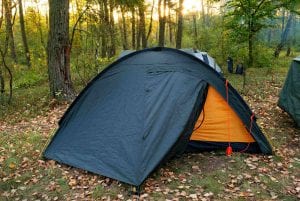As hiking, camping and hunting become more popular, and because bear habitats are shrinking as the United States becomes more developed, there’s a growing likelihood that you might see a bear whether you are out and about, or even in your own backyard…
I’ll dive into detail about how to avoid encounters later. But first, I think it would be useful to explore some bear facts and bear behaviours to emphasise precisely why coming into close contact just isn’t a great idea.
Are Bears Dangerous?
Although bears would rather not come face to face with you, the fact remains that they are extremely large, strong creatures. And whenever you’re dealing with an animal that is bigger than you, there is inevitably an element of danger. Rather than explain how dangerous I think bears can be, let me instead outline a few facts about bears and you can be the judge…
The United States is home to three main bear species: the grizzly bear (also known as the brown bear), the polar bear, and the black bear.
Black Bears
Black bears weigh up to 600lbs (although the ladies are much daintier and won’t tip the scales beyond 400lbs). But they can get even bigger! They’re about 3ft high at the shoulder when on all fours but can be as tall as 7ft when standing on their hind legs. [Source: defenders.org]. According to Gary Brown in his 1993 book The Great Bear Almanac, they can hit speeds of up to 30mph and are so strong, they can flip a 300lb rock in a single movement with one front paw… These bad boys are the smallest of the three North American species.

Grizzly Bears
The females and males can weigh over 400lbs and 800lbs respectively. They can be up to 3.5ft at the shoulder on all fours but when they get up on their hind feet they can be a towering 8ft tall. They can top speeds of 35mph, which is considerably faster than olympic sprinter Ussain Bolt, who clocks a mere 27mph. [Source: animalfactguide.com].

Polar Bears
The big daddy of North American bears is one chunky monkey. The biggest polar bear ever recorded weighed in at over 2,200lbs. Even your average male is a colossal 800lbs-1200lbs. Up to 5ft at the shoulder and 10ft tall standing [Source: livescience.com] and it makes you realise that coming face to face with one is only going to make you feel small and puny. Luckily, your chances of encountering a polar bear is rare unless you live near the Arctic Circle or work in a zoo.

Are Bears Aggressive?
You can see from the stats above that these fellas are bigger n you, taller n you, stronger n you and faster n you. But are they gentle giants? Well, that’s a bit nuanced.
For the most part, bears are not naturally aggressive and only become aggressive when they feel threatened. Usually, if they see a human, they’ll slip away. But you can expect different behaviours in different situations depending on the species.
Like most animals, bears are reasonably territorial. If you enter a bear’s territory, you will be (wittingly or unwittingly) forcing that bear to act. While that action will most often be to run, it can also be to attack.
And if it’s an attack, it’s usually for one of two reasons: you are near a kill or food site, or the bear is protecting its cubs.
Protecting Cubs
Bears will violently defend their cubs if necessary. Bears with first-year cubs, in particular, will attack quickly if you are near them, even if their cubs have already skittered up a tree. Bears with second-year cubs can also be aggressive, and this becomes even more dangerous as the cubs may participate in the charge toward you. This is more common when it is combined with the presence of a kill site.
Protecting Food Sources & Kill Sites
Ever had a friend or family member steal one of your fries? Remember how angry it made you? Now imagine that feeling multiplied by 100 and channelled through a 500lb bear!
I’m being flippant. But our friend Mr Bruin spends a long time asleep during the winter. Summer months are feeding time and they need to pack on the pounds before winter comes around again. And when I say pack on the lbs, a grizzly might put on as much as 3lbs a day during the summer! That means eating is a very serious business for these guys. And that means they are going to be extremely protective of their food sources.
If you find yourself around their berry bushes or an animal carcass, be prepared for a bear to stand their ground rather than run away.
Which Bear is Most Aggressive?
All three bears species have been known to attack. Although black bears are more likely to attack, grizzly bears are more violent, with black bear attacks rarely leading to death. Polar bear attacks are incredibly rare, typically occurring only in captivity. Only about 20 fatal attacks by polar bears have occurred in recorded history. [Source: polarbearscience.com]
Do Bears Eat Humans?
While there is such a thing as bears predating on humans, this is exceedingly rare. Technically, bears are omnivores, meaning they eat both meat and plant-based foods. So yes, as a human, you are a potential source.
But the reality is, this is uncommon. Bears are more likely to eat things like dead animals, roots, berries, deer, fish and seeds. [Source: nps.gov]. A bear that’s predatory is usually either extremely hungry or otherwise thrown from its normal feeding regimen.
That being said, the behaviour of a predatory bear is very different from that of a surprised bear. If you see a bear watching you, following you, slipping in and out of sight, you’ll want to be on very high alert.
Bear Fictions: Dispelling the Biggest Myths About Bears
OK. So we’ve established that bears are big, strong and fast. We’ve also acknowledged that in certain circumstances they may even become aggressive. And all of that suggests the best thing to do is avoid an encounter as best you can.
However, it’s worth knowing the difference between bear fact and bear fiction. Because if you are carrying around information about bears that’s plain wrong it’s not going to help you avoid bears, it’s not going to help you if you see a bear and it’s certainly not going to help you survive a bear attack. So pay close attention. This section is going to cover the most common bear BS.
Can You Outrun a Bear?
Some people believe – wrongly – that in a pinch they could outrun a bear. Don’t fall into this trap – you may not live through it. Bears can run fifty feet per second – which is twice as fast as most people can run. They could outrun a racehorse over a very short distance! [Source: bearsmart.com]. What’s more, if you try to run away, there’s a good chance you’ll encourage the bear to give chase. Don’t try it.
Can Bears Run Downhill?
There is a weird belief in some corners of the internet that bears can’t run downhill. This, too, is false. Bears can run downhill. Fact.
Can Bears Climb Trees?
An old piece of advice given to hikers was to simply hustle up a tree if a bear became aggressive. Both black bears and grizzly bears can climb (although grizzly bears aren’t great) and bears sometimes even kill each other while fighting in a tree. Cubs are much better at scrambling up into trees, and will often hide among the canopy while their mothers defend a threat down below.
Don’t try to climb a tree to avoid a bear.
Sense of Smell
Bears have an excellent sense of smell [Source: myfwc.com]. They can pick up scents from over a mile away, with noses that are more powerful than those of bloodhounds. In fact, bears are considered to have a better sense of smell than any other land mammal.
It’s actually quite important to realize that a bear’s sense of smell can lead to one of the greatest issues that we, as humans, have in our relationship with them. Because bears have such a tremendous appetite and a finely tuned sense of smell, they quickly learn how to find food when they are around humans.
Bears naturally forage on food in the wild, but once bears realize that humans can provide them with an easy supply of food, either through deliberate feeding or accidental exposure, they quickly lose their natural fear of people. As a result, this “food habituation” can cause bears to become reckless, posing a threat to public safety as well as to themselves. You can easily guard against this by refraining from feeding bears and by keeping your food well out of reach.
Bears Have Poor Eyesight
There is a common myth that bears cannot see well. This is not true. Black bears can actually see in color and have excellent eyesight up close. While their long distance eyesight isn’t fantastic, they can see much better than many other species of animals.





